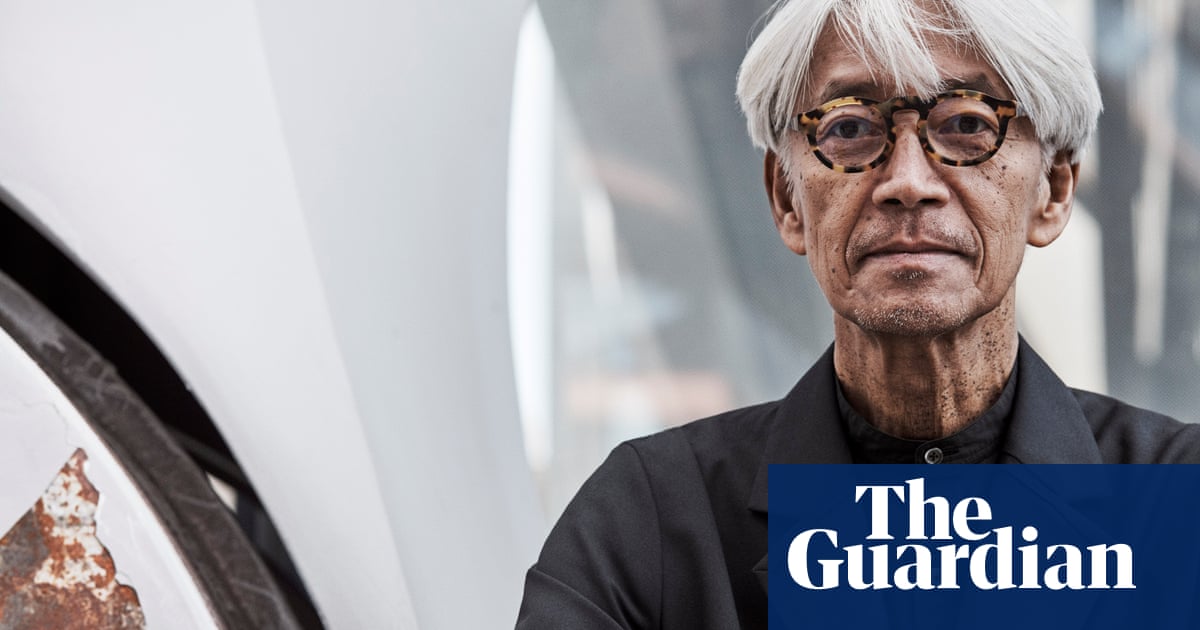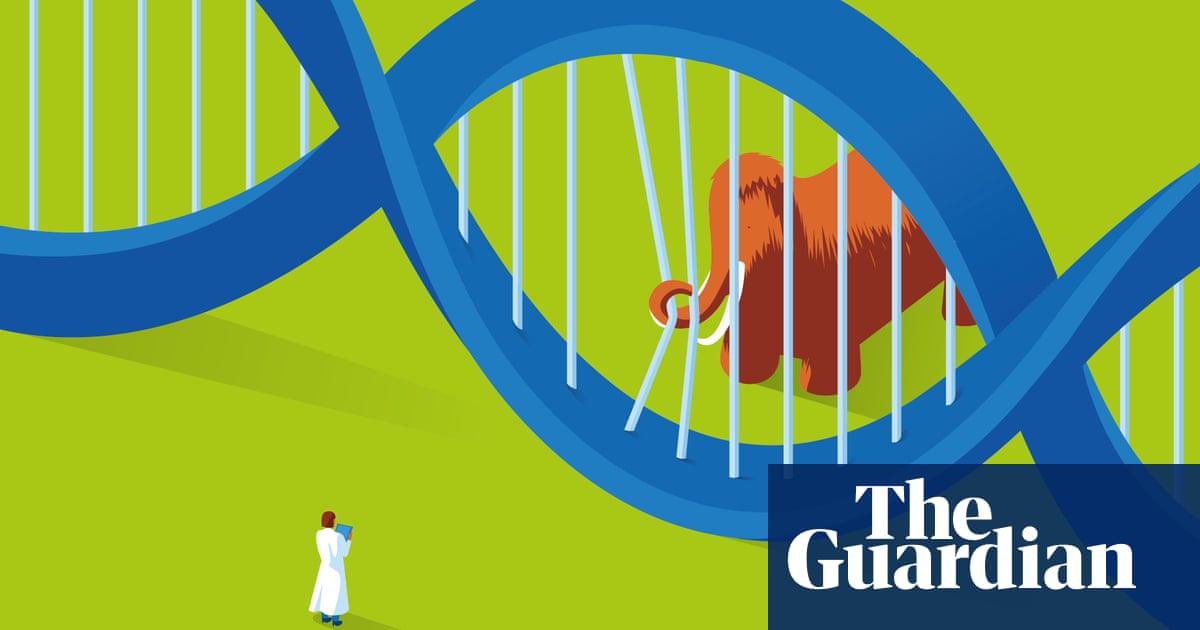
Todd Eckert is explaining, in circuitous yet joyous fashion, how he first fell in love with the work of the Japanese composer Ryuichi Sakamoto. It’s a conversation that meanders through Eckert’s teenage visit to Preston, his years as a punk rock kid in Houston, Texas and his time producing the 2007 Joy Division film Control – yet ultimately always returns to Sakamoto’s astonishing songcraft.
“Merry Christmas, Mr Lawrence was not the first thing of his that I had heard – it may have been Left Handed Dream – but it was the first thing that I totally understood,” he says, sitting outside a Brooklyn cafe in bright yellow trainers.
Over the last few years, Eckert has spent a great deal of time trying to distill his feelings towards Sakamoto and his music as he has worked to create Kagami, a mixed-reality concert, which premiered this past summer at Manchester international festival, and, simultaneously, at The Shed in New York. This December it will appear at the Roundhouse in London.
Kagami is an extraordinary creation for many reasons – the sheer technical wizardry of its making, of course, but also the fact that the work serves as a heartfelt posthumous tribute. In 2014, Sakamoto was diagnosed with oropharyngeal cancer. After treatment, and a long period of remission, he announced a diagnosis of rectal cancer in 2021. He died in late March this year, at the age of 71.
“Kagami is not meant to be a historical overview of his career at all,” Eckert says. “It’s supposed to be an energetic snapshot – because I don’t want anything that smacks of being encyclopaedic or Let Us Praise the Great Man. That’s just bullshit. I want it to be this feeling of currency. This is the way I would do it if he was here with me and that’s really, really important.”
On school mornings in his native Tokyo, the young Ryuichi Sakamoto would pass the cramped commuter journey listening to the sounds made by the train. “Anything can be music,” he would say many years later. “You have to open your ears all the time because anything could happen unexpectedly.”
It was this essential curiosity that governed Sakamoto’s approach to sound throughout his life. Taking up the piano at six, and soon afterwards writing his own compositions, he developed an early fascination with Debussy and Bach. Later, it would be John Coltrane and Ornette Coleman, Kraftwerk and John Cage; then studies in music composition at Tokyo University of the Arts, where his specialisms became electronic music and ethnomusicology.
In 1978, Sakamoto joined Haruomi Hosono and Yukihiro Takahashi to form the pioneering electronic band Yellow Magic Orchestra; their influence would be felt everywhere from techno to acid house and hip-hop. That same year, he released his first solo album, Thousand Knives, which drew influences from Herbie Hancock, synthesisers, classical piano, Chinese history and the poetry of Mao Zedong.
In the four and a half decades that followed, Sakamoto’s work continued to show great diversity: collaborations with David Sylvian, Talking Heads, Iggy Pop, Youssou N’Dour, Brian Wilson; a starring role, alongside David Bowie, in Nagisa Oshima’s Merry Christmas, Mr Lawrence, for which he also composed the score; a multi-genre, multi-media opera, Life, with contributions from Pina Bausch, Salman Rushdie, Bernardo Bertolucci and the Dalai Lama; multi-sensory collaborations with sculptors, mobile phone makers, champagne houses; 21 solo studio albums; Oscar-winning scores for The Last Emperor and The Revenant; an audio portrait of the passing of time, which included field recordings from New York, Tokyo, Kyoto and Paris, forest leaves underfoot, a tsunami-drowned piano, synths, strings and the poetry of Arseny Tarkovsky.
Capturing the essence of this approach to music was the challenge for Eckert and his studio, Tin Drum. When Kagami was unveiled, audiences wore “optically transparent devices” through which they were able to watch Sakamoto at the piano, playing 10 compositions from Energy Flow to The Seed and the Sower. There was surround sound, a specially created scent, and throughout the performance, the audience members could rise from their seats and wander about.
But the elegance of the event told little of the intricacy of its creation which required a volumetric capture studio with 48 cameras, all capturing 60 frames a second.
Further complication was added by Sakamoto’s request to use a concert grand piano. The original plan was to shoot using a keyboard with weighted keys – a method that had worked well in test runs, and allowed for all camera angles. The size and structure of the grand piano, Eckert realised, would occlude many of the camera shots. Still, recognising how important the request was to the composer, he agreed.
When all of the captured data came back five months later, Eckert’s heart sank. The images were so distorted that “Ryuichi, half the time, looked like one of those chestnuts that’s been split open.” But all was not lost. “I’m very fortunate to work with some unbelievable technologists,” he says, “and we created what is tantamount to a dimensional reconstruction. Ultimately we were able to put his face back together again.”
It was a relief on many levels. There was after all no possibility of rerecording what had been an extraordinary and profoundly emotional performance. Eckert explains how on the first morning of filming in Tokyo, Sakamoto had visited his oncologist, where he had learned that his cancer had returned with a vengeance. “And so all of the gravity of life, of his career, of everything, you could feel in every note.”
When they were discussing the pieces to be played for Kagami, Eckert asked Sakamoto whether he had any compositions that nobody had ever heard. Sakamoto promised to think about it, and the subject remained unbroached until the second day of shooting. “We were talking about what went well the day before, what can go better, this kind of stuff,” Eckert recalls, “and he says ‘Oh oh oh you wanted a song that nobody’s ever heard!’ and he goes over to his bag and he comes back and shows me this piece of sheet music that says ‘BB’ at the top. He says ‘That stands for Bernardo Bertolucci. He was a spiritual father to me and when I got the call that he had died I walked into my studio and I played how I felt about him. The only people who have ever heard this song are his family at the funeral. Will that work?’”
They chose to end the Kagami performance with the piece. “People have said ‘Do you want to record it? Do you want to put it out as a single?’” Eckert says. “But I said no. I want it to be emphatically un-Googleable.”
The first time I spoke to Eckert was early in the year when the composer was gravely ill. “The fact that he’s still alive now is a testament to how much he loves life and he’s always been a really curious person,” Eckert told me then. “He’s somebody who has no interest in talking about all of the things that he did to make him famous, but he can sit around and talk about the reverberations of a sound in a glass that you pick up in a truck stop. He’ll talk about that all day long.”
Despite Sakamoto’s subsequent passing, Eckert hopes that Kagami captures some of that same spirit. Across the many years of their friendship and collaboration, Eckert feels he came to understanding the composer’s impetus. “The whole idea of any medium is that it can elucidate something that just words alone can’t,” he says. “For Ryuichi, it was: ‘How do I create a greater understanding of the human condition with the tool that I have, which is this instrument? And that’s all that music is.”
Kagami is at the Roundhouse, London from 29 December 2023 until 21 January 2024. General tickets on sale from 2 November. First ticket release available until 15 November











